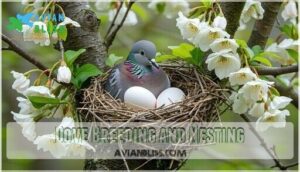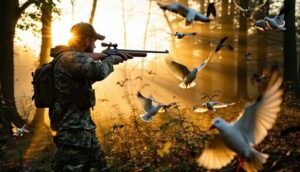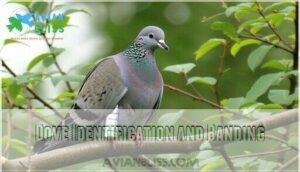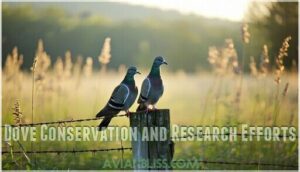This site is supported by our readers. We may earn a commission, at no cost to you, if you purchase through links.
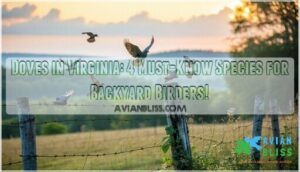
Mourning Doves rule the roost, with their soft gray plumage and gentle cooing, while Rock Pigeons strut around urban landscapes.
The Eurasian Collared-Dove‘s been making waves, expanding its territory across the Commonwealth. These feathered friends aren’t just pretty faces—they’re ecological indicators, thriving in agricultural fields and backyard habitats.
Whether you’re a wildlife enthusiast or casual observer, Virginia’s dove population offers a fascinating glimpse into local avian dynamics. Want to know how these birds survive and thrive?
Table Of Contents
- Key Takeaways
- Types of Doves in Virginia
- Dove Breeding and Nesting
- Dove Hunting Regulations in Virginia
- Dove Habitat and Food Sources
- Dove Identification and Banding
- Dove Conservation and Research Efforts
- Frequently Asked Questions (FAQs)
- Are doves good to have in your yard?
- What is the difference between a spotted dove and a mourning dove?
- What does it mean when you see a dove in your backyard?
- What is dove season in Virginia?
- What type of doves are in Virginia?
- Are doves a good bird to have around?
- What day does dove season come in in Virginia?
- How can I attract doves to my backyard?
- What do doves symbolize culturally in Virginia?
- Are doves affected by climate change in Virginia?
- Conclusion
Key Takeaways
- You’ll discover four main dove species call Virginia home: Mourning Doves, Rock Pigeons, Eurasian Collared-Doves, and White-winged Doves, each bringing unique characteristics to the state’s diverse ecosystems.
- As a birder or hunter, you’ll need to stay informed about dove hunting regulations, including specific season dates (September to January) and bag limits, to ensure a responsible and legal hunting experience.
- You can attract doves to your backyard by creating a welcoming habitat with ground-level seed feeders, native vegetation like sunflowers and millet, and open water sources that support their feeding and nesting needs.
- Climate change is impacting dove populations, forcing these adaptable birds to modify their migration patterns, breeding habits, and survival strategies across Virginia’s changing landscapes, affecting their overall breeding habits and survival strategies.
Types of Doves in Virginia
If you’re a backyard birder in Virginia, you’ll be thrilled to discover the diverse dove species that grace our local landscapes.
From the familiar Mourning Dove to the urban Rock Pigeon, these feathered friends will transform your understanding of these peaceful, seed-loving birds that are as much a part of Virginia’s ecosystem as the rolling hills and verdant forests, making them a key part of the ecosystem.
Discover Virginia’s doves: tiny feathered guardians dancing through landscapes, weaving life into our wild, breathing ecosystems.
Mourning Dove Characteristics
Out among the suburban landscapes of Virginia, you’ll spot the graceful Mourning Dove, a feathered friend that’s become a backyard icon.
Their distinctive features include:
- Soft grayish-brown plumage that shimmers in sunlight
- Distinctive black wing spots like tiny celestial markers
- Delicate blue eye-rings framing gentle, expressive faces
- Tapered tails that dance through the air with elegant motion
Their melodic "coo-ah, coo, coo" calls are a signature soundtrack of Virginia’s wild spaces.
About 12 inches long, these dove species are masters of ground foraging, blending scientific precision with natural beauty in every flutter and song, showcasing their unique ability to bring life to your garden with their presence.
Rock Pigeon Identification
As you venture beyond the Mourning Dove’s gentle grays, meet the Rock Pigeon—Virginia’s urban bird superstar! These feathered city dwellers showcase stunning Pigeon Plumage with blue-gray heads and distinctive dark wing bars.
- Listen for their soft "coo" echoing through city streets
- Watch their plump bodies waddle on sidewalks
- Spot their iridescent neck feathers shimmering in sunlight
Rock Pigeons are masters of Urban Habitats, displaying incredible Feather Patterns that range from classic blue-gray to mottled designs. Perfect for budding bird enthusiasts, these adaptable creatures turn dove species identification into an exciting urban adventure.
Eurasian Collared-Dove Habitat and Behavior
If Rock Pigeons rule city streets, Eurasian Collared-Doves are the suburban pioneers of Virginia’s bird world.
These adaptable invaders, marked by their distinctive black neck ring, arrived in 2007 and quickly claimed their territory.
You’ll spot them perched on power lines or foraging in backyard gardens and agricultural fields, building simple platform nests near human activity.
Masters of urban adaptation, they’ve turned habitat loss into an opportunity, proving their resilience in Virginia’s changing landscapes.
Dove Species Similarities and Differences
After exploring the unique Eurasian Collared-Dove, let’s compare Virginia’s feathered friends.
Each dove species brings its own personality to the backyard birding scene.
Here’s how they stack up:
- Size Matters: Mourning Doves dance delicately, while Collared-Doves strut confidently
- Plumage Palette: Gray, brown, and white feathers tell their own stories
- Vocal Signatures: Each species sings a different tune
- Feeding Flair: Ground-feeding strategies reveal their survival secrets
Spot the differences and become a dove detective in Virginia’s wild backyard!
Dove Breeding and Nesting
If you’re a backyard birder in Virginia, you’ll be fascinated by the intricate breeding and nesting habits of local dove species.
From the Mourning Dove’s multiple broods to the Rock Pigeon’s urban nesting strategies, these feathered friends have unique reproductive patterns that’ll surprise even seasoned bird enthusiasts.
Nesting Conditions in 2022
If you’ve been wondering about dove success in Virginia, 2022 was a golden year for these feathered friends! The perfect combination of mild temperatures and steady rainfall created prime conditions for dove breeding habits.
Here’s what made nesting so successful:
- Abundant food sources near agricultural lands
- Protected nesting sites with horizontal branches
- Favorable weather patterns supporting egg laying and fledgling success
Mourning doves and Eurasian Collared-Doves took full advantage of these ideal circumstances. Bird enthusiasts spotted multiple clutches throughout the season, with nest boxes and natural habitats bustling with activity.
Young doves flourished in Virginia’s diverse landscapes, from coastal plains to mountainous regions. The installation of dove nesting boxes can markedly enhance dove breeding success.
Nature’s recipe for dove prosperity? A dash of sunshine, a sprinkle of rain, and plenty of seeds to go around!
Spring Weather Patterns in Virginia
Virginia’s springtime paints a dynamic backdrop for dove breeding, where temperature fluctuations and storm patterns dance across the landscape.
Weather forecasting becomes your secret weapon in understanding dove migration patterns. Shifting climate trends ripple through bird habitats, influencing nestling survival and reproductive success.
Nature’s pulse beats through bird migrations, revealing the delicate dance of climate, survival, and hope.
As rainfall trends ebb and flow, doves in Virginia adapt their nesting strategies. Each unexpected cold snap or warm spell can dramatically impact dove species’ breeding behaviors, turning nature’s unpredictability into a thrilling game of environmental adaptation. The dynamic interplay of these factors makes dove migration patterns a fascinating subject to study.
Dove Production and Hunting Success
Frequently, a mild spring sets the stage for robust dove populations in Virginia.
Your hunting success hinges on strategic scouting and understanding local dove dynamics.
Consider these key tactics:
- Target freshly harvested fields where mourning doves congregate, maximizing your chances of a productive hunt.
- Monitor crop harvest dates to predict dove feeding patterns and optimize hunting strategies in prime dove habitats.
By combining sharp observation with smart hunting tactics, you’ll transform your dove hunting experience from ordinary to extraordinary.
Understanding the role of dove conservation efforts is essential for maintaining healthy dove populations and ensuring successful hunts.
Dove Hunting Regulations in Virginia
If you’re a dove hunter in Virginia, you’ll need to know the state’s specific hunting regulations to guarantee a safe and legal hunting experience.
Understanding season dates, bag limits, and wildlife management area rules will help you plan your hunting trips and contribute to responsible wildlife conservation.
This knowledge will help you have a successful and enjoyable hunting experience in Virginia.
Season Dates and Hours
Ready to spread your wings and hunt Virginia’s doves?
The 2024-2025 season unfolds across three exciting segments: September 2-21, October 22-November, and December 22-January 20.
Hunters can take flight from 30 minutes before sunrise until sunset, perfectly timed with dove flocking patterns to maximize your hunting success in VA’s wild landscapes.
Bag Limit and Hunting Requirements
Before heading out to hunt doves across Virginia’s sprawling landscapes, make sure you’ve got all your hunting ducks in a row! Managing dove hunting requires more than just enthusiasm—you’ll need the right permits and know-how.
- Secure a valid hunting license
- Pack appropriate camouflage gear
- Submit accurate harvest reports
- Follow hunter safety guidelines
Bag limits change annually, so always check current Virginia wildlife regulations before loading your shotgun and hitting the field. It’s essential to stay informed about hunter safety guidelines and wildlife regulations to ensure a successful and safe hunting experience.
Dove Hunting on Wildlife Management Areas
Explore Virginia’s Wildlife Areas for an unforgettable dove hunting season.
Scout fields where doves gather during migration, set decoys, and create smart hunting tactics.
Know the rules—bag limits, safety gear, and ethics matter.
Hunting supports conservation efforts, so respect wildlife management and bird behavior.
Go prepared and enjoy the freedom of a crisp morning outdoors while contributing to bird conservation.
Dove Habitat and Food Sources
If you want to attract doves to your backyard, you’ll need to understand their food preferences and habitat requirements.
Native grains, agricultural crops, and open spaces with scattered trees will help you create an inviting environment that’ll have these peaceful birds flocking to your yard in no time, utilizing the habitat requirements to their fullest potential.
Agricultural Crops for Doves
Across Virginia’s farmlands, doves find their culinary paradise through strategic agricultural crops.
These feathered foragers thrive on diverse food sources that transform fields into bustling buffets.
- Millet provides essential nutrition
- Sunflowers offer seed-rich havens
- Grain sorghum fuels dove populations
Smart seed selection and harvest timing create the perfect dove dining experience across Virginia’s agricultural landscapes.
Farmers considering millet crops should research the best millet seed sources for millet seed options.
Importance of Native Vegetation and Grains
Attract Virginia’s native dove species by transforming your backyard into a seed sanctuary.
Native sunflowers, millet, and diverse grain crops create a natural buffet that supports local dove populations.
Your bird-friendly landscape not only nourishes our feathered friends but also maintains a thriving ecosystem where Virginia’s dove species can flourish and feed.
Corn Harvest Dates and Dove Feeding Patterns
Since corn is king in dove country, understanding harvest dates can make or break your bird-watching adventure.
Here’s what you need to know about Virginia’s dove dining:
- Sweet corn planted April 1-May 15
- Harvest peaks early July-August
- Doves feast on residual grain
- Cornfields with standing strips attract birds
- Native foods supplement grain diet
- September harvest opens prime feeding grounds
To attract doves and other birds, consider implementing best bird feeding practices in your backyard, focusing on complete concepts and key practices for a successful bird-watching adventure.
Dove Identification and Banding
When you spot a dove in your Virginia backyard, you’ll want to know exactly what species you’re looking at.
Learning to identify and recognize the unique bands on these feathered friends can turn your casual bird-watching into a fascinating scientific adventure.
Reporting Banded Doves and Importance of Research
When you spot a banded dove, you’re not just a casual observer—you’re a citizen scientist!
Jump into dove tracking by carefully logging unique band details from Mourning Doves, Eurasian Collared-Doves, and Rock Pigeons.
Your data helps wildlife researchers understand bird migration, population dynamics, and conservation needs in Virginia.
Each report is a vital piece of the research puzzle, contributing to our understanding of these fascinating feathered friends.
To improve your birding skills, mastering a thorough bird identification guide is essential for accurate species recognition.
Distinguishing Between Mourning and Eurasian Collared-Doves
Binocular-wielding birders, welcome to Dove Detective 101! When distinguishing Mourning and Eurasian Collared-Doves in Virginia, keen observation is your secret weapon.
Here’s your field guide:
- Size matters: Mourning Doves are petite compared to their larger cousins
- Check neck details: Black collar screams Collared-Dove
- Plumage tells a story: Grayish-brown vs. sandy brown feather patterns
Happy dove identification, wildlife watchers!
Dove Conservation and Research Efforts
You’ll love discovering how Virginia’s dove conservation efforts are making a real difference in protecting these peaceful backyard birds.
By tracking dove populations through banding programs and smart hunting regulations, researchers are helping guarantee these feathered friends continue to thrive in our state’s diverse landscapes, through conservation efforts.
National Dove Population and Habitat Trends
If you’re tracking dove populations in Virginia, you’ll find fascinating shifts on the landscape.
The continental mourning dove population hovers around 350 million, with the Eastern Management Unit showing a stable 0.6% increase over a decade.
Urban expansion and climate impacts are reshaping habitats, creating a dynamic environment for these resilient birds across the state.
Understanding bird conservation efforts is essential for managing dove populations effectively, and recognizing the importance of bird conservation is crucial.
The Role of Bird Banding in Conservation Efforts
Every bird bander becomes a detective in Virginia’s wildlife conservation story! Bird banding helps researchers crack the code of dove populations through strategic tracking methods.
Here’s how you make a difference:
- Contribute valuable data about dove migration patterns
- Help scientists understand population dynamics
- Support long-term wildlife monitoring efforts
Effective bird banding requires proper equipment, including Bird Banding Kits, to guarantee accurate and reliable data collection.
Your simple act of reporting banded birds transforms research, protecting Virginia’s precious dove habitats and populations, which is crucial for dove populations and supports long-term conservation goals, ultimately contributing to wildlife conservation efforts.
Importance of Hunting Regulations and Research
Many hunters play a vital role in dove conservation through carefully crafted regulations.
Hunting helps manage wildlife populations while supporting research efforts:
- Set strategic bag limits to protect dove populations
- Preserve critical nesting habitats across Virginia
- Gather essential data through ethical hunting practices
By balancing wildlife management and sustainable hunting, we guarantee the future of these remarkable bird species in Virginia.
Frequently Asked Questions (FAQs)
Are doves good to have in your yard?
On 47% of summer checklists, doves can enhance your yard’s ecosystem.
They’re peaceful, seed-eating birds that attract wildlife, provide natural pest control, and add a gentle, soothing presence to your outdoor sanctuary.
What is the difference between a spotted dove and a mourning dove?
You’ll spot key differences between spotted and mourning doves: Spotted doves sport unique color patterns with black-and-white speckles, while mourning doves feature soft gray-brown plumage with distinctive black wing spots.
What does it mean when you see a dove in your backyard?
With 47% of backyards hosting doves, spotting one often signals peace and tranquility.
You’re witnessing a gentle messenger, symbolizing hope and connection to nature’s serene rhythm, inviting calm into your personal sanctuary.
What is dove season in Virginia?
You’ll enjoy dove hunting in Virginia from early September to early January.
Check the state’s wildlife regulations for specific dates, bag limits, and required licenses before heading out to the fields.
What type of doves are in Virginia?
By sheer coincidence, you’ll find four dove species calling Virginia home: the Mourning Dove, Rock Pigeon, Eurasian Collared-Dove, and White-winged Dove.
They’re diverse, adaptable birds that’ll catch your eye in urban and rural landscapes, showcasing their ability to thrive in various environments, making them a notable sight with their urban presence.
Are doves a good bird to have around?
Doves are fantastic backyard companions that’ll brighten your day.
They’re peaceful, help control weed seeds, and attract other wildlife.
With their gentle cooing and graceful presence, they’ll transform your outdoor space into a tranquil sanctuary.
What day does dove season come in in Virginia?
When autumn’s first whispers blow, Virginia hunters mark their calendars.
Dove season typically opens in early September, giving wing-shooters a chance to pursue these graceful feathered friends during a regulated hunting period.
How can I attract doves to my backyard?
Create a dove sanctuary with ground-level seed feeders, scattered sunflower seeds, and open water sources.
Plant native shrubs for shelter, and keep your yard predator-free to welcome these peaceful feathered friends to your backyard haven.
What do doves symbolize culturally in Virginia?
Gentle wings unfurl hope’s silent whispers. In Virginia, doves symbolize peace and spiritual grace, carrying messages of reconciliation through their soft, pure presence across cultural landscapes and human hearts.
Are doves affected by climate change in Virginia?
You’ll notice dove populations shifting as warmer temperatures disrupt migration patterns and food sources.
Climate change impacts their breeding habitats, forcing adaptations in feeding, nesting, and survival strategies across Virginia’s changing landscapes, particularly affecting their migration patterns.
Conclusion
Peering through binoculars or wandering backyard trails, you’ll discover Virginia’s doves are more than just feathered friends—they’re ecological storytellers.
Whether you’re tracking Mourning Doves or spotting Eurasian Collared-Doves, understanding doves in Virginia offers a fascinating window into local wildlife dynamics.
Your newfound knowledge transforms casual observation into meaningful connection, revealing how these birds adapt, survive, and thrive in the Commonwealth’s diverse landscapes, making them feathered friends.

